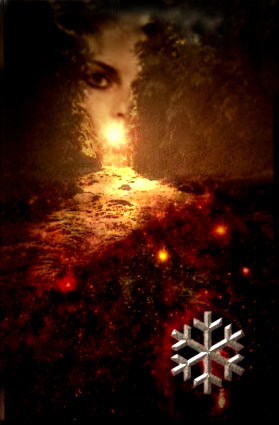The Helvegr is the road to Hel, it
is the magickal path that leads to Hela. Helvegr is
also the name of a Helish email group. As a list, Helvegr
sits twilight-like between the worlds of scholarly research
and personal experience with Hela and Her family; both
are equally valid.
The group's focus is primarily on
Hela, but other aspects of Rökkr tradition are
also open to discussion. Hela has issued a call for
Her children to come home, and it is being answered
today in ever increasing numbers.
THE ORIGINAL HELVEGR
The Helvegr, or Hel-Way, is the path
that leads to Hel. It is travelled by the dead, and
by the shamans who make the journey to Hela and Her
underworld queendom. The Helvegr is represented in
the sky by the Milky Way. The association of this
band of stars with the path of the dead is almost
universal. In Egypt, the Milky Way was seen as the
celestial form of the Nile, which flowed from the
udders of Isis-Hathor; in India it was the river Ganges;
while the Norse river of souls was the twelve-fold
rivers of Elivagar, as well as being the path of Helvegr.
The Akkadians called the Way the River of the Divine
Lady, or Hiddagal, the Great River. Similarly, Arabian
astrologers considered the Milky Way Umm al Sama,
the Mother of the Sky. The Milky Way was consequently
a way to return to the realm of the goddess, and for
this purpose it was travelled by not only spirits
seeking eternal return, but shamans who sought wisdom,
encounters with the divine, or to retrieve the souls
of people taken too soon.
Hela, in the form of the elven pyschopomp
Mordgud, waits at the end of the Helvegr to welcome
shamans, and the spirits of the dead. A veritable
world away, the Nicaraguan goddess Itoki (Mother
Scorpion) does likewise. She stands at the end
of the Milky Way to welcome her dead; and then gives
birth to them again as new souls. In the kozmology
of the Lakota, the Milky Way is guarded by an old
goddess called Hihankara (Owl Maker), who checks
every soul for an identifying tattoo; if they do not
have it, they are pushed back to earth where they
become ghosts. Likewise, the Roman scholar Macrobius
described how the souls of the dead ascend into the
night sky through the sign of Capricorn, and then
descend through Cancer, the sign lying at the opposite
end of the Milky Way; a physical stargate for the
souls was, thus, the point of intersection between
the tail of the Milky Way and the band of the zodiac.
The gate of Hel would, then, have been on the edge
of the sky, where the Milky Way intersected with the
zodiac band. Importantly, within the context
of Rökkr astrology, Cancer is represented by
Gjall, the final underworld river that must be traversed
before one can enter Hela's hall of Elvidner.
When Hermod, the messenger of the
gods, travelled nine days along Helvegr to visit Hel,
to bargain with Hela for the soul of his brother Balder,
he was making a shamanic journey along the Milky Way,
riding on the horse Sleipner (metaphorically a shamanic
drum). A parallel to Hermod's journey can be found
in the account of an Alaskan shaman. He was dead,
and followed the road of the dead for two days, well-trodden
by those who had walked it before; as he walked, he
heard continual crying, which he learned was the living
mourning their dead. After a time, he came to a village
that looked exactly like his own village, where two
shades took him inside a house, in which a central
fire was lit, and pieces of meat broiled on the coals.
They told him not to touch the meat; for a shaman
who eats of the food of the dead, finds it hard to
return to earth. After he had rested for a time, the
shaman continued on his journey, reached the Milky
Way, and followed it until it arrived back at his
own grave. Re-entering his own body, he came back
to life, and told his people of his adventure.



![]()
![]()
![]()
![]()
![]()
![]()